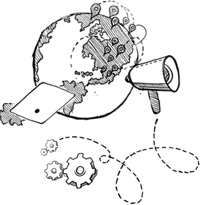|
What You’ll Learn
|
A business plan is more than a document—it’s your company’s blueprint for success. Whether you’re launching a solo freelance venture or managing a growing team, this plan outlines who you are, what you do, and how you’ll achieve your goals. It helps you clarify your strategy, organize resources, and anticipate risks. But, beyond internal guidance, it also demonstrates to others—like investors, lenders, and partners—that your business has direction, purpose, and potential.
1. Spot Challenges Before They Become Problems
One of the biggest advantages of a business plan is its ability to reveal what could go wrong—before it actually does. From unrealistic sales targets to underestimated expenses, a well-structured plan forces entrepreneurs to confront the numbers early. Instead of relying on assumptions, you’re now using facts to build a roadmap. This clarity helps you tackle risks head-on and adjust your strategy before issues derail your momentum.
2. Get Smarter, More Targeted Advice
The importance of a business plan to entrepreneurship can also lie in the way it clarifies exactly what kind of help you need. Merely telling a friend or potential business mentor you're aiming to start with ten employees, for example, is not an exceptionally detailed statement.
A vague business idea gets vague feedback. But a detailed business plan? That gets actionable insights. When you present mentors, partners, or advisors with a plan that outlines staffing, roles, goals, and financials, they can offer real guidance—not just guesswork. The more clarity you have, the more helpful others can be.
3. Map Out Your Resources and Costs
Your business plan is the tool that turns your ideas into actionable numbers. It helps you assess what you can afford—from office space and equipment to staffing and monthly expenses. You’ll see exactly where your money is going and whether your business model is financially viable. This level of insight is essential for making smart, confident decisions.
4. Win Investor Confidence
If you’re seeking funding, your business plan isn’t just helpful—it’s essential. Investors want to see that you’ve done your homework, crunched the numbers, and thought through the risks. A strong plan communicates strategy, scalability, and financial logic, giving investors the confidence they need to say “yes.”
5. Set Milestones That Drive Growth
A business plan transforms your vision into a series of actionable steps. By setting clear short-, medium-, and long-term goals, you provide your team with a roadmap—and a way to measure success. These milestones help you track progress, adapt quickly, and stay aligned with your strategy as your business evolves.
Whether you're launching your first venture or refining your strategy, a solid business plan is the foundation of success. Business may have some artistry to it, but real success comes from having a vision and being organized in the way you strive towards that vision. A business plan will help you immensely in many ways.
|
TL;DR (Key Takeaways)
|
Simple Business Plan Template for Entrepreneurs
Ready to validate your business idea? This easy-to-follow template will walk you through each step of the planning process—from defining your vision to mapping out your finances. Whether you're building a startup or refining an existing concept, use this structure to organize your thoughts, align your strategy, and move forward with confidence.
Section 1: Executive Summary
Write an executive summary. The purpose of the executive summary is to provide readers with a high-level overview of the company and the market before delving into the details. It appears first but is written last, providing a snapshot of your company that explains who you are, what you do, and why. The executive summary provides a concise and optimistic overview of your business, capturing the reader's attention and creating a desire to learn more.
✅ Purpose: High-level overview of your business, market, and value proposition.
💡 Tip: Write this last—after all other sections are complete.
Section 2: Business/Industry Overview
Describe your company and business model by summarizing what your company does, your mission statement, location details, business structure, and business owner details, the marketplace needs that your business is trying to meet, and how your products/services meet those needs. Define your business's purpose (mission) and a statement based on your perception of the company's growth potential (vision). Include specific business goals and objectives. Provide background information about the company, including a brief history of the business and a list of fundamental company principles.
✅ Purpose: Describe your company, mission, vision, structure, and location.
💡 Tip: Explain the market need your business meets and how your product or service solves it.
Section 3: Market Analysis and Competition
Analyze your market's conditions. The market will ultimately determine the success of your business. You will need to demonstrate that you have thoroughly analyzed your target market and have a high enough demand for your products/services to make your business viable. The competitive analysis should include a comprehensive assessment of your competition and how your business will compete in the sector. Describe the industry within which your business will operate, identify and provide a general profile of your target market, and describe what share of the market you currently have or anticipate. Include both an analysis of research done by others, along with primary research you have collected yourself — whether via customer surveys, interviews, or other methods. Outline the strengths and weaknesses of potential competitors and strategies that will give you a competitive advantage.
✅ Purpose: Detail your target market, trends, and demand.
💡 Tip: Analyze your competition and explain how you’ll stand out.
Section 4: Sales and Marketing Plan
Design a marketing and sales strategy. Here is where you can plan out your comprehensive marketing and sales strategies to outline how you plan to sell your product. Before developing your marketing and sales plan, you will need to have a comprehensive market analysis in place and select your target client personas, i.e., your ideal customers. Talk about the competitive landscape. Describe how you intend to entice customers to buy your products or services, including advertising and promotion, sales and distribution, pricing strategy, and post-sales support.
✅ Purpose: Define your customer personas and go-to-market approach.
💡 Tip: Include pricing, promotion, distribution, and post-sale support.
Section 5: Ownership and Management Plan
Outline all operations and management roles. This section describes the ownership, legal structure, and management and staffing requirements of your business. Use this section to outline your company's unique organizational and management structure. Describe how your company is organized, including its legal structure (sole proprietorship, partnership, corporation); identify any special licenses or permits your business operates with; provide a brief bio of key managers within your company; include an organization chart.
✅ Purpose: Outline legal structure, leadership bios, staffing needs, and licenses/permits.
💡 Tip: Add an org chart if available.
Section 6: Operating Plan
The operating plan outlines your business's physical requirements, including office space, warehouse space, retail space, equipment, inventory, supplies, and labor. For a one-person, home-based consulting firm, the operating plan may be short and straightforward. However, for businesses such as restaurants or manufacturers that require custom facilities, supply chains, multiple employees, and specialized equipment, the operating plan may need to be very detailed.
✅ Purpose: Describe physical space, equipment, inventory, and systems needed to run your business.
💡 Tip: Scale details to your business type (e.g., simple for consultants, complex for manufacturers).
Section 7: Financial Plan
This section is the most crucial part of the business plan, particularly if you require debt financing or aim to attract investors. The financial plan must demonstrate your business's growth and profitability potential. To do this, you will need to provide projected income statements, cash flow statements, and balance sheets. For new businesses, these are forecasts. A golden rule of thumb is to underestimate revenues and overestimate expenses. Outline your financial model, including your business costs, revenue projections, and a funding request if you pitch to investors. Your start-up cost refers to the resources you will need to get your business up and running — and an estimate of how much each of those resources will cost.
✅ Purpose: Define startup costs, revenue model, and funding needs.
💡 Tip: Include 3–5 year projections: income statement, balance sheet, and cash flow.
Section 8: Appendices and Exhibits
Summarize the above with an appendix. The appendices and exhibits section should contain any detailed information needed to support other areas of the plan, including company brochures, resumes of key employees, a list of business equipment, copies of press articles and advertisements, pictures of your business location and products, any applicable information about your industry or products, key business agreements such as leases, and contracts.
💡 Tip: Add visuals, resumes, charts, product photos, articles, legal docs, etc.
Who Should Use a Business Plan?
Business plans aren’t just for startups—they’re for any entrepreneur who wants to grow with purpose.
Start-up Businesses: New ventures use business plans to clarify goals, secure funding, and break down uncertainty into actionable steps. From projecting revenue to defining milestones, a business plan helps founders stay focused and make smarter decisions.
Existing Businesses: Existing companies rely on business plans to refine strategy, manage growth, and respond to market changes. They use them to track performance, plan resources, and align teams with evolving business goals.
How to Choose the Right Type of Business Plan
Not all business plans are created equal. The format, tone, and level of detail should reflect your audience and business goals. Are you pitching investors? Planning internally? Building a highly technical product? Each scenario requires a distinct approach.
For example, if you are building a biotech firm plan, it will detail the government approval processes. If you are writing a restaurant plan, details about location and renovations might be critical factors. The language you would use in the biotech firm's business plan would be much more technical than the language you would use in the restaurant plan. Plans can also differ significantly in length, detail, and presentation. Those that never leave the office and are used only for internal strategic planning and management may often use more casual language and might not have much visual polish. On the other end of the spectrum, a plan destined for a top venture capitalist's desk will have a high polish, focusing on the business's high-growth aspects and the experienced team that will deliver desirable results.
What matters most is aligning the plan with your business type—and the readers you need to convince.
Core Elements Found in Every Business Plan
While formats may differ, most business plans include a common set of components. These foundational elements give structure to your strategy and make your plan actionable:- Review Schedule: When and how the plan will be revisited and updated.
- Strategy Summary: A concise statement of your goals and business model.
- Milestones: Key targets with associated deadlines.
- Responsibilities: Who’s accountable for what.
- Metrics: Measurable KPIs like sales, conversions, or market share.
- Financial Projections: Forecasts for revenue, costs, profit, and cash flow.
These building blocks bring clarity to your vision—and credibility to your pitch. These core elements grow organically to meet the actual purpose needed by the business.
How to Develop a High-Impact Business Plan
Writing a business plan isn’t just about checking boxes—it’s about building a tool that drives real results. This section outlines a proven six-stage process to help you create a business plan that’s strategic, realistic, and aligned with your long-term goals.
Stage 1: Conduct Foundational Research
Every strong business plan starts with research. Analyze trends at the market, industry, and customer levels to understand where your business fits—and what risks or opportunities you may face. This early research grounds your plan in reality and gives you the insights you’ll need to make strategic decisions later.
Stage 2: Define Your Business Model
Your business model explains how your company creates, delivers, and captures value. Use this stage to clarify key elements such as your revenue streams, cost structure, customer segments, and value proposition. This step ensures your plan reflects a viable path to profitability—and communicates it clearly to stakeholders.
Stage 3: Draft the Full Business Plan
Now it’s time to bring everything together. Using insights from your research and business model, create a first full draft of your business plan. Include all key sections—business overview, mission, goals, marketing strategy, operations, HR, and financial projections. At this stage, your goal is structure and completeness, not perfection.
Stage 4: Refine Your Plan for Realism
Most first drafts are too optimistic—and that’s okay. This stage is about adjusting your plan based on real-world data, financial constraints, and operational feedback. Make sure the narrative sections align with your financial projections. The more accurate and consistent your plan, the more useful—and fundable—it becomes.
Stage 5: Tailor the Plan for Investors and Stakeholders
A realistic plan isn’t enough—it also needs to inspire confidence. At this stage, refine your messaging, visuals, and projections to target your intended audience directly. Investors want scalability and returns; partners want alignment and clarity. Ensure the plan remains grounded in reality, but present it in a way that’s compelling to the people who matter.
Stage 6: Finalize and Polish Your Plan
With all the content in place, it’s time to refine and polish things. Double-check that your financials align with the written sections, correct any inconsistencies, and format the document professionally. Add charts, visuals, and a compelling executive summary that captures attention. This final polish makes your plan presentation-ready—and reinforces your credibility.
|
TL;DR (Key Takeaways)
|
Build Your Future with a Plan That Works
Whether you're launching a startup or scaling an existing business, a solid plan gives you clarity, direction, and a competitive edge. By following the stages outlined above, you’ll move from vague ideas to a strategic, investor-ready roadmap.
Ready to get started? Download our free guide for entrepreneurs to access expert insights, proven templates, and the tools you need to write a business plan that delivers real results.
|
FAQs About Business Plans Q: What is the main purpose of a business plan for entrepreneurs? Q: How detailed should a business plan be? Q: Can I start a business without a formal business plan? Q: How often should a business plan be updated? Q: Do investors still read business plans in 2025? Q: What are the 4 types of business plans? Q: What are the 3 main purposes of a business plan? Q: What are the 5 elements of a business plan? |







